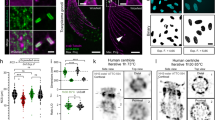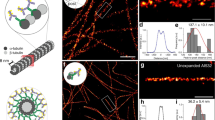Abstract
Determining the structure and composition of macromolecular assemblies is a major challenge in biology. Here we describe ultrastructure expansion microscopy (U-ExM), an extension of expansion microscopy that allows the visualization of preserved ultrastructures by optical microscopy. This method allows for near-native expansion of diverse structures in vitro and in cells; when combined with super-resolution microscopy, it unveiled details of ultrastructural organization, such as centriolar chirality, that could otherwise be observed only by electron microscopy.
This is a preview of subscription content, access via your institution
Access options
Access Nature and 54 other Nature Portfolio journals
Get Nature+, our best-value online-access subscription
$29.99 / 30 days
cancel any time
Subscribe to this journal
Receive 12 print issues and online access
$259.00 per year
only $21.58 per issue
Buy this article
- Purchase on Springer Link
- Instant access to full article PDF
Prices may be subject to local taxes which are calculated during checkout



Similar content being viewed by others
Data availability
The data that support the findings of this study are available from the corresponding authors upon request.
References
Koster, A. J. & Klumperman, J. Nat. Rev. Mol. Cell Biol. 4, SS6–SS10 (2003).
Sahl, S. J., Hell, S. W. & Jakobs, S. Nat. Rev. Mol. Cell Biol. 18, 685–701 (2017).
Chen, F., Tillberg, P. W. & Boyden, E. S. Science 347, 543–548 (2015).
Chozinski, T. J. et al. Nat. Methods 13, 485–488 (2016).
Tillberg, P. W. et al. Nat. Biotechnol. 34, 987–992 (2016).
Ku, T. et al. Nat. Biotechnol. 34, 973–981 (2016).
Hamel, V. et al. Curr. Biol. 27, 2486–2498 (2017).
Klena, N. et al. J. Vis. Exp. 2018, e58109 (2018).
Heilemann, M. et al. Angew. Chem. Int. Ed. Engl. 47, 6172–6176 (2008).
Fortun, D. et al. IEEE Trans. Med. Imaging 37, 1235–1246 (2018).
Heine, J. et al. Proc. Natl Acad. Sci. USA 114, 9797–9802 (2017).
Pigino, G. et al. J. Cell. Biol. 195, 673–687 (2011).
Lechtreck, K. F. & Geimer, S. Cell Motil. Cytoskeleton 47, 219–235 (2000).
Kubo, T., Yanagisawa, H. A., Yagi, T., Hirono, M. & Kamiya, R. Curr. Biol. 20, 441–445 (2010).
Kubo, T. & Oda, T. Mol. Biol. Cell. 28, 2260–2266 (2017).
Suryavanshi, S. et al. Curr. Biol. 20, 435–440 (2010).
Gao, M. et al. ACS Nano 12, 4178–4185 (2018).
Halpern, A. R., Alas, G. C. M., Chozinski, T. J., Paredez, A. R. & Vaughan, J. C. ACS Nano 11, 12677–12686 (2017).
Yang, T. T. et al. Nat. Commun. 9, 2023 (2018).
Borlinghaus, R. T. & Kappel, C. Nat. Methods 13, i–iii (2016).
De Luca, G. M. R. et al. J. Microsc. 266, 166–177 (2017).
Göttfert, F. et al. Proc. Natl Acad. Sci. USA 114, 2125–2130 (2017).
Ovesný, M., Křížek, P., Borkovec, J., Švindrych, Z. & Hagen, G. M. Bioinformatics 30, 2389–2390 (2014).
Wolter, S. et al. Nat. Methods 9, 1040–1041 (2012).
Thévenaz, P., Ruttimann, U. E. & Unser, M. IEEE Trans. Image Process. 7, 27–41 (1998).
Unser, M., Soubies, E., Soulez, F., McCann, M. & Donati, L. GlobalBioIm: a unifying computational framework for solving inverse problems. OSA Technical Digest https://doi.org/10.1364/COSI.2017.CTu1B.1 (2017).
Schindelin, J. et al. Nat. Methods 9, 676–682 (2012).
Schneider, C. A., Rasband, W. S. & Eliceiri, K. W. Nat. Methods 9, 671–675 (2012).
Royer, L. A. et al. Nat. Methods 12, 480–481 (2015).
Acknowledgements
We thank N. Klena for critical reading of the manuscript. We thank the BioImaging Center (University of Geneva) for help in image acquisition. We thank the Martinou lab and especially S. Zaganelli for helpful discussions and sharing of mitochondrial reagents. Human U2OS cells were a gift from E. Nigg (Biozentrum, University of Basel, Basel, Switzerland). D.G. and M.S.-C. are supported by the European Research Council (ERC; StG 715289 (ACCENT)). P.G., V.H., and M.L.G. are supported by the Swiss National Science Foundation (SNSF; PP00P3_157517). F.U.Z. and M.S. acknowledge support by the Deutsche Forschungsgemeinschaft (DFG) within the Collaborative Research Center 166 ReceptorLight (projects A04 and B04). M.U. is supported by the ERC (GA No. 692726 GlobalBioIm).
Author information
Authors and Affiliations
Contributions
D.G., F.U.Z., M.S., V.H., and P.G. conceived and designed the project. M.S., V.H., and P.G. supervised the project. D.G. and F.U.Z. performed all ExM experiments. D.G. performed all U-ExM experiments with the help of S.B., as well as the data analysis. F.U.Z. performed the dSTORM imaging and the experiment and analysis involving clathrin-coated pits. J.H., J.-G.S., and M.R. performed and analyzed the STED imaging. D.F. and M.U. performed the 3D averaging. M.S.-C. initiated the U-ExM project. M.L.G. performed the plot profile of the polar transform showing the ninefold symmetry, as well as the r.m.s. calculation. E.S.B. helped in setting up ExM. All authors wrote and revised the final manuscript.
Corresponding authors
Ethics declarations
Competing interests
The authors declare no competing interests.
Additional information
Publisher’s note: Springer Nature remains neutral with regard to jurisdictional claims in published maps and institutional affiliations.
Supplementary information
Supplementary text and figures
Supplementary Figures 1–19
Supplementary Video 1
U-ExM of isolated Chlamydomonas centrioles. Confocal (HyVolution) stack of immunolabeled Chlamydomonas centrioles in U-ExM. Magenta corresponds to α-tubulin, and green to PolyE. Scale bar, 1 µm.
Supplementary Video 2
3D rendering of isolated Chlamydomonas centrioles treated by U-ExM. 3D rendering of the confocal stack from Supplementary Video 1. Note the polyglutamylation signal (PolyE; green) along the microtubule triplets of the mature centrioles. Scale bar, 1 µm.
Supplementary Video 3
DyMIN imaging of U-ExM isolated Chlamydomonas centrioles. Stack of immunolabeled Chlamydomonas centrioles treated by U-ExM and imaged with DyMIN. Magenta corresponds to α-tubulin, and green to PolyE. Scale bar, 1 µm.
Supplementary Video 4
Supplementary Video 4U-ExM of Chlamydomonas cell. Confocal (HyVolution) stack of an immunolabeled Chlamydomonas cell treated by U-ExM. Magenta corresponds to α-tubulin, and green to PolyE.
Rights and permissions
About this article
Cite this article
Gambarotto, D., Zwettler, F.U., Le Guennec, M. et al. Imaging cellular ultrastructures using expansion microscopy (U-ExM). Nat Methods 16, 71–74 (2019). https://doi.org/10.1038/s41592-018-0238-1
Received:
Accepted:
Published:
Issue Date:
DOI: https://doi.org/10.1038/s41592-018-0238-1
This article is cited by
-
Fine-tuning FAM161A gene augmentation therapy to restore retinal function
EMBO Molecular Medicine (2024)
-
Molecular basis promoting centriole triplet microtubule assembly
Nature Communications (2024)
-
Protein and lipid expansion microscopy with trypsin and tyramide signal amplification for 3D imaging
Scientific Reports (2023)
-
iU-ExM: nanoscopy of organelles and tissues with iterative ultrastructure expansion microscopy
Nature Communications (2023)
-
A PPP-type pseudophosphatase is required for the maintenance of basal complex integrity in Plasmodium falciparum
Nature Communications (2023)



